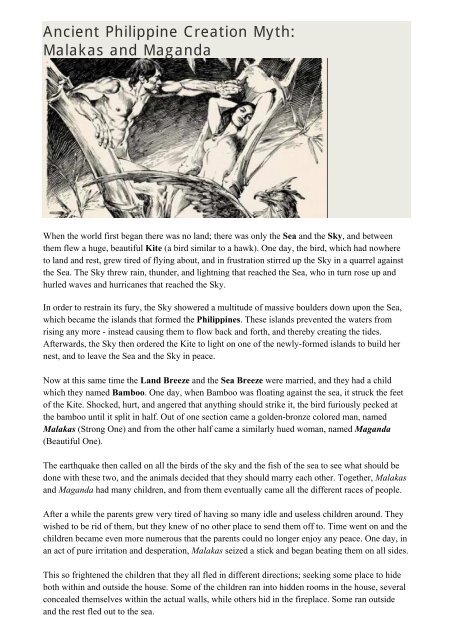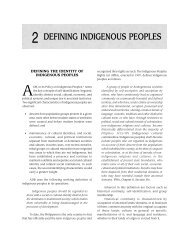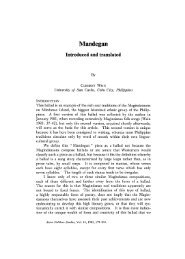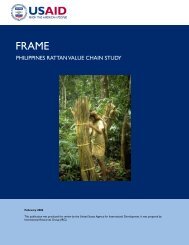Ancient Philippine Creation Myth: - Philippine Culture
Ancient Philippine Creation Myth: - Philippine Culture
Ancient Philippine Creation Myth: - Philippine Culture
Create successful ePaper yourself
Turn your PDF publications into a flip-book with our unique Google optimized e-Paper software.
<strong>Ancient</strong> <strong>Philippine</strong> <strong>Creation</strong> <strong>Myth</strong>:<br />
Malakas and Maganda<br />
When the world first began there was no land; there was only the Sea and the Sky, and between<br />
them flew a huge, beautiful Kite (a bird similar to a hawk). One day, the bird, which had nowhere<br />
to land and rest, grew tired of flying about, and in frustration stirred up the Sky in a quarrel against<br />
the Sea. The Sky threw rain, thunder, and lightning that reached the Sea, who in turn rose up and<br />
hurled waves and hurricanes that reached the Sky.<br />
In order to restrain its fury, the Sky showered a multitude of massive boulders down upon the Sea,<br />
which became the islands that formed the <strong>Philippine</strong>s. These islands prevented the waters from<br />
rising any more - instead causing them to flow back and forth, and thereby creating the tides.<br />
Afterwards, the Sky then ordered the Kite to light on one of the newly-formed islands to build her<br />
nest, and to leave the Sea and the Sky in peace.<br />
Now at this same time the Land Breeze and the Sea Breeze were married, and they had a child<br />
which they named Bamboo. One day, when Bamboo was floating against the sea, it struck the feet<br />
of the Kite. Shocked, hurt, and angered that anything should strike it, the bird furiously pecked at<br />
the bamboo until it split in half. Out of one section came a golden-bronze colored man, named<br />
Malakas (Strong One) and from the other half came a similarly hued woman, named Maganda<br />
(Beautiful One).<br />
The earthquake then called on all the birds of the sky and the fish of the sea to see what should be<br />
done with these two, and the animals decided that they should marry each other. Together, Malakas<br />
and Maganda had many children, and from them eventually came all the different races of people.<br />
After a while the parents grew very tired of having so many idle and useless children around. They<br />
wished to be rid of them, but they knew of no other place to send them off to. Time went on and the<br />
children became even more numerous that the parents could no longer enjoy any peace. One day, in<br />
an act of pure irritation and desperation, Malakas seized a stick and began beating them on all sides.<br />
This so frightened the children that they all fled in different directions; seeking some place to hide<br />
both within and outside the house. Some of the children ran into hidden rooms in the house, several<br />
concealed themselves within the actual walls, while others hid in the fireplace. Some ran outside<br />
and the rest fled out to the sea.
Now it happened that those who went into the hidden rooms of the house later became the chiefs of<br />
the islands (Maharlikas); and those who concealed themselves in the walls became slaves (Alipins).<br />
Those who hid in the fireplace became the Negritos and the Aetas; and those who ran outside turned<br />
into free men (Timawas). As for those who fled to the Sea; they were gone many years, and when<br />
their children eventually came back, they had become the white foreigners.<br />
Notes<br />
Because the <strong>Philippine</strong>s has so many islands and is inhabited by different ethnic groups, <strong>Philippine</strong><br />
mythology and superstitions are very diverse. Even the story of Malakas and Maganda vary from<br />
region to region, but specific elements of the story remain the same: there is a huge bird that splits a<br />
giant bamboo, and Malakas and Maganda emerge from the halves.<br />
The names Malakas and Maganda also denote a deeper meaning and truth about Pilipino<br />
culture. Pilipinos consider women to be maganda - beautiful, sweet, and soft; while men as<br />
malakas - a strong and sturdy being to whom the family can depend on at all times.<br />
The final part about the children who fled out to the sea and eventually came back as “white<br />
foreigners” seems to have been added to the original version that had been handed down orally over<br />
the years from generation to generation.<br />
Ref.: http://bakitwhy.com/articles/ancient-philippine-creation-myth-malakas-and-maganda

















